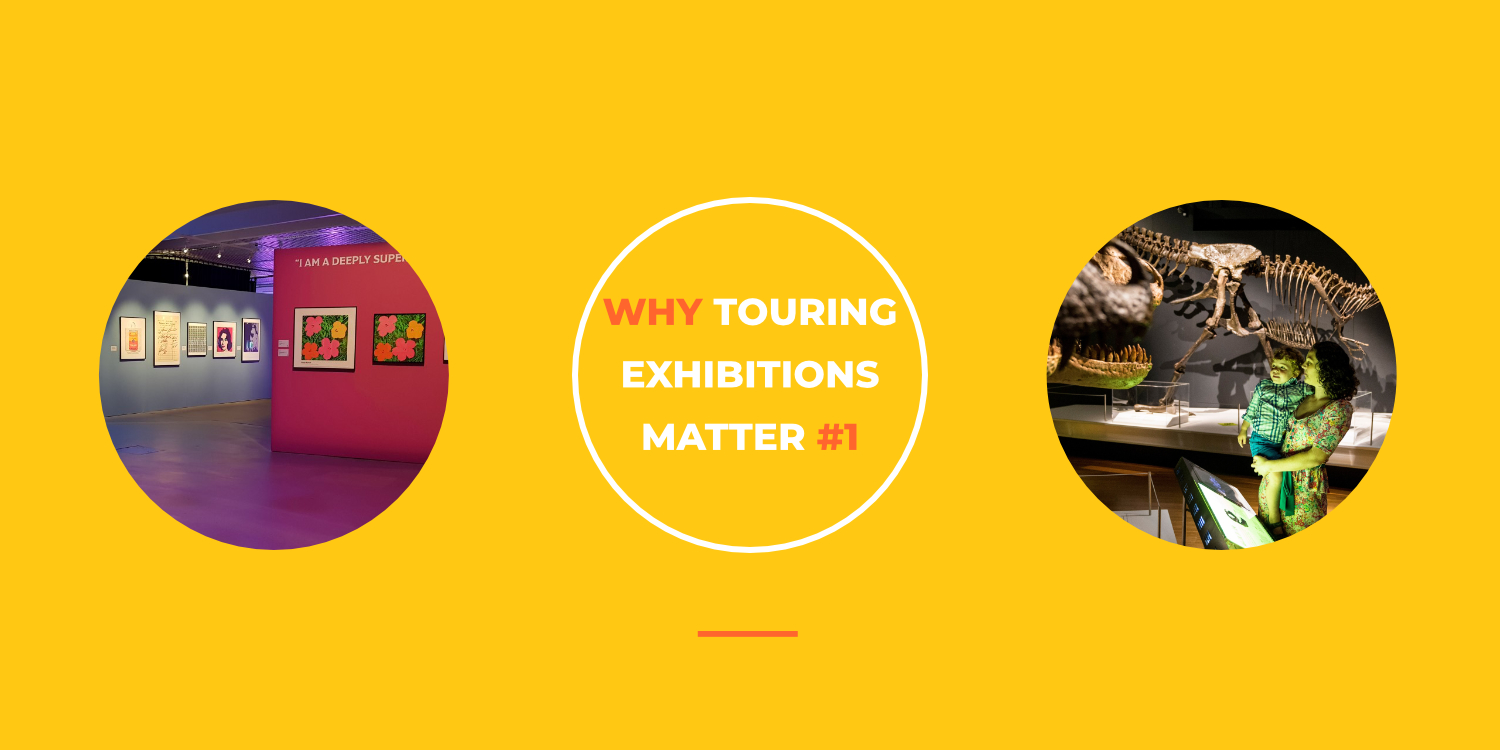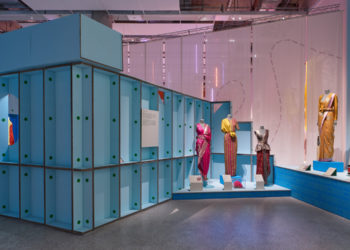#1 – A new dialogue framework with local audiences is the first article in the Why Touring Exhibitions Matter series by Teo. This series of articles aims to highlight the value of travelling exhibitions in the context of the multi-layered crisis cultural institutions and their audiences are currently facing. The series questions how these creative productions and the collaborations they foster are essential sources of value for cultural institutions and their audiences at large, and how they will be, and already are, key resources for recovery in the cultural world and beyond. In this first article, we explore how travelling exhibitions can be vital resources to nurture, reinvent and enrich connections to existing and potential local audiences.
A disruptive shift in focus
Now can be a unique opportunity for cultural organisations in their history to meet again with their local audiences: the people who live in the same geographical area, those who can come to the museum and be back home in the same day, those who regularly pass by and those who can see signs from the institution around their city because they also live here – the locals, all potential visitors. At this unique time in history, local inhabitants have found themselves unable to travel, while tourist audiences have shrunk in an unprecedented manner. The whole cultural and live entertainment industry is being challenged, with potential visitors facing a changing landscape of cultural offers with new constraints, uncertainties and possibilities. In this parenthesis of time, cultural institutions have a card to play in the arena, by researching new ways to engage with local communities and to differentiate themselves from other local cultural offers.
This shift in relationships induced by travel bans is particularly impactful for cultural organisations for whom local audiences might not have historically been the priority focus of attention. These organisations, essentially major international museums in global tourist hubs, are usually very busy catering to international audiences, designing programmes and exhibitions that appeal to them, so as to guarantee continuous flows of tourists and reach ever growing attendance targets. For these organisations, the disruptive shift in focus is even more a key occasion to (re)connect with the local.
As cards are being reshuffled, a window of opportunity has opened for institutions to rethink their relationship with all local audiences, and to reinvent communication, dialogue and engagement.
New encounters can be fostered with occasional and regular visitors as well as with audiences who do not often or ever visit, especially the “visitors who have an interest in attending museums and performance-based organizations but who have not done so in the last two years”, who Colleen Dilenschneider, Chief Market Engagement Officer at IMPACTS Experience, refers to as “inactive visitors” 1. Cultural institutions have indeed a chance, in this reconfigured landscape, to focus more, and more ambitiously, on developing an inclusive reach within the territories they are embedded in. As cards are being reshuffled, a window of opportunity has opened for institutions to rethink their relationship with all local audiences, and to reinvent communication, dialogue and engagement.
A balance for in-house resources and solutions
Bringing new elements to permanent displays, or even fully redesigning them, designing engaging temporary exhibits with their own collections, telling local stories, and designing new community engagement programmes are certainly obvious areas of action that can be leveraged and lead to a positive impact, as multiple initiatives have already demonstrated.
But fully relying on these might not always be feasible or desirable. Firstly, because many of these actions are based on medium to long term developments, and the dialogue with local audiences needs attention now. Secondly, because it puts particular pressure on institutions’ resources, especially time, staff, funds and ideas, which are already strained by the multiple crisis that has massively impacted the cultural industry. It indeed seems particularly risky to put creativity and productivity pressure on staff who have just had to undergo the urgent reorganisation of complex programmes, increased workloads, stressful lockdown situations, and staff reductions and salary cuts for some. This could jeopardise the sustainability of teams in the long run, when in fact preserving these internal intangible assets is so badly needed for the cultural organisations’ future.
Incoming travelling exhibitions, bringing new content, workforce and experiences, can be a powerful answer to feed the cultural offer of an institution and complement in-house resources and solutions. When financially balanced, this could give these institutions the breathing space they so urgently need while powering their relationships with local audiences in new ways.
Excitement and the urge to engage with a special experience can [...] spur people on to take that leap of faith to visit public cultural spaces.
Overcoming barriers to visitation
As highlighted in the research carried out by IMPACTS Experience and shared by Colleen Dilenschneider in her article The Five Biggest Barriers to Attending Cultural Entities in 2020 1, many people interested in visiting a cultural institution in the US were not doing so before the crisis, and even fewer have been doing so since the multi-layered crisis started.
The research highlights that the key barriers to visitation are, in order of importance, coronavirus concerns, preferring an alternative leisure activity, public safety concerns and access challenges. The fifth barrier with a very high index value is “nothing new to do or see”. These barriers, with variations in intensity and ranking connected to local specifics, can be key filters for worldwide cultural venues to consider when thinking of strategies to engage regionally.
In a climate of increased uncertainty, when some potential local visitors might not feel comfortable visiting cultural institutions, working on the “nothing new” barrier in a way that meaningfully complements the venue’s displays and programmes could act as leverage to weaken other barriers. Despite effective health protocols being successfully implemented across cultural institutions, potential visitors might not feel an urge to come and see existing displays, or local treasures newly presented, feeling that they will be able to come and enjoy these when health risks and, in some countries, security risks, have decreased and protocols have been eased. Excitement and the urge to engage with a special experience can help overcome anxiety and hesitations and spur people on to take that leap of faith to visit public cultural spaces.
Attracting audiences with the exceptional
In the abovementioned context, travelling experiences coming to town for a limited time, supported by dedicated communication efforts geared towards local audiences, and augmented with special outreach programmes and events, have the potential to be that exceptional offer that will draw local visitors to a cultural venue. They can provide that extra incentive to overcome doubts and reluctances for visitors who were inactive before the crisis emerged as well as for new visitors who have become inactive because of the unrest. They have the power to contribute to tell local audiences that even through the crisis, and in particular through the crisis, the cultural institution has the ability to continue to achieve its mission to foster knowledge, education and engagement with science and art.
Travelling productions often have that quality of the rare and precious that should not be missed, not only through the experience itself, but also through all the satellite educational programmes and activities.
These exhibitions, when they complement in-house productions and programmes well and add a layer of meaning and relevance, can represent a real resource to bring fresh and exceptional content to local audiences. A hosted production can be exceptional in many ways: in its time-limited presence, making a visit a once in a lifetime opportunity; in the treasure character of the collections brought to town, encouraging visitors to come for this special encounter; and in the unique stories or experiences proposed, offering visitors new knowledge and new discoveries that they will not otherwise be able to access locally. Travelling productions often have that quality of the rare and precious that should not be missed, not only through the experience itself, but also through all the satellite educational programmes and cultural activities designed around the event.
They also are often focused on popular, instantly recognisable and appealing topics, of wide resonance, which have proven power to draw larger crowds, and also to attract new audiences, to cultural venues – including the inactive visitors who were not visiting cultural institutions before, whose attention might be easier to catch as they reconsider leisure options in the context of the unique crisis. Carefully selected, they can bring new light to existing displays and create new opportunities to discover and rediscover the rich experiences the institution continuously offers.
Sources
1 Dilenschneider, C. (2020, September 16). The Five Biggest Barriers to Attending Cultural Entities in 2020 (DATA). Retrieved 5 October 2020, from https://www.colleendilen.com/2020/09/16/the-five-biggest-barriers-to-attending-cultural-entities-in-2020-data/
Exhibitions featured in the cover image
Andy Warhol Posters, By Pan Art Connections
Tyrannosaurs, Meet the Family, by the Australian Museum



